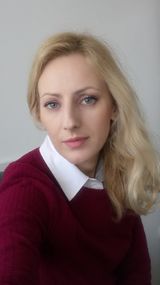From Bioblast
| News and Events | Working Groups | Short-Term Scientific Missions | Management Committee | Members |
COST Action CA15203 (2016-2021): MitoEAGLE
Evolution-Age-Gender-Lifestyle-Environment: mitochondrial fitness mapping
Jusic Amela
MitoPedia topics: EAGLE
COST: Member
COST WG4: WG4
| Name | Jusic Amela, Dr. |
|---|---|
| Institution | University of Tuzla
Faculty of Natural Sciences and Mathematics Biology Department |
| Address | Univerzitetska 4, 75 000 |
| City | Tuzla |
| State/Province | |
| Country | Bosnia and Herzegovina |
| [email protected] | |
| Weblink | |
| O2k-Network Lab |
Labels:
Publications
| Published | Reference | |
|---|---|---|
| BEC 2020.1 doi10.26124bec2020-0001.v1 | 2020 | Gnaiger E et al ― MitoEAGLE Task Group (2020) Mitochondrial physiology. Bioenerg Commun 2020.1. https://doi.org/10.26124/bec:2020-0001.v1 |
| Jusic 2019 MitoFit Preprint Arch EA | 2019 | Jusic Amela, Hajrulahovic A, Devaux Y (2019) Noncoding RNAs regulatory network in mitochondria. https://doi.org/10.26124/mitofit:ea19.MiPSchool.0006 |
Abstracts
| Published | Reference | |
|---|---|---|
| Jusic 2019 ESCI2019 | 2019 | Jusic A, Gnaiger E (2019) Feedback and mutual expectations: COST Action CA15203 MitoEAGLE MC member Bosnia and Herzegovina. |
MitoEAGLE Short-Term Scientific Mission
- Work Plan summary
- The main aim of this visit is training for the optimization of the protocols for high-resolution respirometry of intact and permealized human peripheral blood mononuclear cells (hPBMC). In line with that, I will be trained how to apply the protocols for hPBMC preparation in order to measure oxidative phosphorylation with a high-resolution respirometry techniques (Oroboros-O2k) allowing the study of mitochondrial function in blood cells. Based on the experience and knowledge that I will get, it could lead to the introduction of learned methods in home laboratory.
- Description of the work to be carried out during the STSM
- The schedule of my visit is planned as following:
- The 12th January 2020: arrival to Verona
- The 13th January 2020: develop a training plan for forthcoming period.
- The 14th to 23th January 2020: training in laboratory techniques for (1) hPBMCs preparation: blood sampling, transport, storage and isolation; (2) training in high-resolution respirometry techniques (Oroboros-O2k), (3) describing achieved work in a lab book and (4) preparing a report containing all results.
- The 24th January 2020: the presentation of results and evaluation of STSM with the members of the Department of Neurological and Movement Sciences.
- The 25th January 2020: departure from Verona.
- The main aim of this visit is training for the optimization of the protocols for high-resolution respirometry of intact and permealized human peripheral blood mononuclear cells (hPBMC). In line with that, I will be trained how to apply the protocols for hPBMC preparation in order to measure oxidative phosphorylation with a high-resolution respirometry techniques (Oroboros-O2k) allowing the study of mitochondrial function in blood cells. Based on the experience and knowledge that I will get, it could lead to the introduction of learned methods in home laboratory.
- Work Plan summary
- Brief explanation of the choice for the host institution, such as host lab expertise. Please detail what techniques or equipment you may learn to use, if applicable.
- The Department of Neurological and Movement Sciences, University of Verona, Italy is selected as host institution due to that it contains very high standard laboratory equipment (Oroboros-O2k) and their expertise in using high-resolution respirometry techniques for investigation of mitochondrial function in blood cells. Furthermore, Department of Neurological and Movement Sciences has the access to specimens from human subjects, which will allow me to address the value of obtained results as biomarkers for mitochondrial dysfunction and linked disease phenotype.
- Expected outputs of the STSM are:
- Set-up of a collaboration with the research group at Department of Neurological and Movement Sciences, University of Verona, Italy.
- Introducing high-resolution respirometry methods and protocols for the investigation of mitochondrial function in blood cells of cardioavscular disease (hypertension) paients in home laboratory.
- Through this STSM, the Host institution will gain into visibility. It will be, for both the Host and Home institutions, an opportunity to set-up joint research projects aiming at further deciphering the role of mitochondrial dysfunction in different pathologic phenotypes including cardiovascular disease. Indeed, this will represent a significant result of the COST Action and will contribute to its goal to share knowledge and expertise, as well as to engage in international and multidisciplinary collaborations. Hence, this STSM covers objectives of WG4 (data repository for blood cells and cultured cells).




